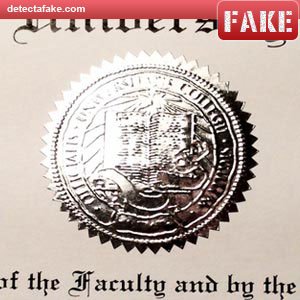How to detect fake College Degrees & Diplomas
| Step | Description |
|---|---|
| 1 | Verify the college name by searching the internet; ensure the address matches the one on the document |
| 2 | Check for an embossed seal; fake diplomas may lack a seal or feature a deceptive one |
| 3 | Inspect signatures for authenticity; genuine signatures have slight indents and trailing edges |
| 4 | Scrutinize the entire document for spelling errors; authentic diplomas maintain a high level of accuracy |
| 5 | Look for watermarks; major universities often use hologram watermarks visible against a bright light |
Tackling the Challenge of Fake Diplomas
The proliferation of counterfeit documents, especially in the form of fake diplomas, has become a global issue. With “diploma mills” producing degrees that appear genuine at first glance, it’s crucial to adopt a discerning eye to distinguish real qualifications from fraudulent ones. Let’s delve into the steps necessary to effectively spot a fake diploma.
Spotting Fake Diplomas: A Comprehensive Guide
-
College Name Verification: Start your scrutiny by examining the name of the college on the diploma. Many diploma mills use official-sounding names that don’t correspond to legitimate institutions. Verify the name by conducting an internet search. Ensure the search results match the address on the document. If verification fails, it’s likely a fake.


Example: Think of it as confirming the legitimacy of a company; the details should align with reality.
-
Embossed Seal Inspection: Authentic diplomas typically have an embossed seal. Inspect the diploma for this feature, as it’s often absent in fake documents. Be cautious, as some counterfeit diplomas may have deceptive seals. Do not assume legitimacy solely based on the presence of a seal; further examination is crucial.


Example: It’s like ensuring the official stamp on a document is genuine; the seal should be both present and accurate.
-
Signature Authenticity: Focus on the signatures on the diploma. Genuine signatures are in actual ink, leaving slight indents and trailing edges that don’t abruptly end. If the signatures appear printed or lack these characteristics, it raises suspicions of a fake document.

Example: Imagine signing a document with a pen; the ink leaves distinct marks.
-
Spelling Error Scrutiny: Conduct a thorough examination of the entire document for spelling errors. Legitimate diplomas maintain a high standard of accuracy, and any spelling issues, as seen in the example, indicate a likely fake.

Example: Consider it like proofreading an official document; precision is essential.
-
Watermark Verification: Genuine diplomas from major universities often feature hologram watermarks that are visible only when held in front of a bright light. Look for these watermarks as they serve as an additional layer of security.

Example: It’s akin to recognizing a genuine banknote; certain features become visible under specific conditions.
Safeguarding the Integrity of Educational Credentials
In an era where fake diplomas abound, staying vigilant is paramount to maintaining the integrity of educational qualifications. The steps outlined above empower individuals to differentiate between authentic degrees and deceptive documents. By incorporating these measures, we contribute to upholding the credibility of educational achievements and safeguarding against the pervasive issue of fake diplomas.
